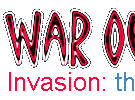War of the Worlds TV Series (1988)
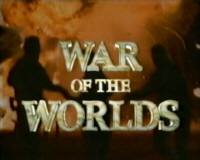
This television series is intended as a quasi-sequel to the 1953 War of the Worlds movie and even
attempts to tie in the 1938 Orson Welles broadcast, so you can certainly credit it with a great
deal of ambition. That the first season is so good is a testament to the writers
and cast, who by and large, rose above the rather weak central premise, that a
form of blanket amnesia has wiped out our collective memories of the 1953 attack.
Of course, one can sympathise with the decision, as American television is not
noted for its risk taking, and to have made a direct sequel to the movie would
have required the engineering of a completely different history for our planet
from 1953 to modern days. Far easier from the point of view of audience acceptance
and ease of production to set everything in a readily recognisable world. (And for
the sake of economy, this invariably meant Canada where the show was filmed.)
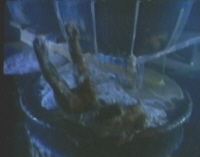 The series begins with a terrorist attack on a nuclear waste repository. Little
do the terrorists realise, but the sealed drums of nuclear waste actually contain
the bodies of Martians placed there by the military in 1953 and since forgotten
about. By fluke and accident, the waste has not only preserved the aliens in a
form of suspended animation, but given them a resistance to the germs that stopped
the first invasion. Now released by the attack, the Martians set about taking
over the bodies of the hapless terrorists. (Another major deviation from established
lore) and prepare to receive a fresh invasion wave.
The series begins with a terrorist attack on a nuclear waste repository. Little
do the terrorists realise, but the sealed drums of nuclear waste actually contain
the bodies of Martians placed there by the military in 1953 and since forgotten
about. By fluke and accident, the waste has not only preserved the aliens in a
form of suspended animation, but given them a resistance to the germs that stopped
the first invasion. Now released by the attack, the Martians set about taking
over the bodies of the hapless terrorists. (Another major deviation from established
lore) and prepare to receive a fresh invasion wave.
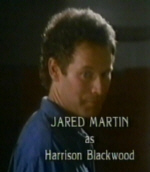 Clearly the
aliens need to be tracked down, and so the task is given to a maverick
scientist named Harrison Blackwood, (his parents were killed in the 53 invasion)
played with a great deal of enthusiasm by Jared Martin. Joining his team is a rather
formulaic but better than normally fleshed out group of disparate personalities. Clearly the
aliens need to be tracked down, and so the task is given to a maverick
scientist named Harrison Blackwood, (his parents were killed in the 53 invasion)
played with a great deal of enthusiasm by Jared Martin. Joining his team is a rather
formulaic but better than normally fleshed out group of disparate personalities.
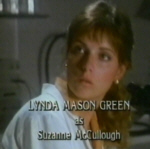 Directly assisting Harrison on the science side of the project is microbiologist Suzanne McCullough
(played by Lynda Mason Green), though her scientific methods are
rooted in a rational view of her discipline, making for a sometimes uncomfortable
relationship with the thoroughly untraditional Blackwood. She is also estranged from her husband and is trying
to juggle saving the world with being a single parent mum.
Directly assisting Harrison on the science side of the project is microbiologist Suzanne McCullough
(played by Lynda Mason Green), though her scientific methods are
rooted in a rational view of her discipline, making for a sometimes uncomfortable
relationship with the thoroughly untraditional Blackwood. She is also estranged from her husband and is trying
to juggle saving the world with being a single parent mum. 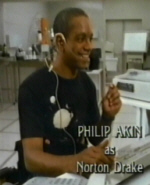 All good teams need a
computer whiz, and in this case the technical smarts are provided by the wheelchair
bound Norton Drake, played by Philip Akin. Drake still manages to get into the field despite his disability. Nice to see a disabled character
getting in on the action. Providing exasperated military support
to the loony civilians is All good teams need a
computer whiz, and in this case the technical smarts are provided by the wheelchair
bound Norton Drake, played by Philip Akin. Drake still manages to get into the field despite his disability. Nice to see a disabled character
getting in on the action. Providing exasperated military support
to the loony civilians is 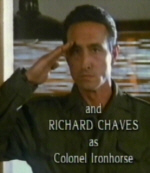 Lt Col Paul Ironhorse (Richard Chavez); a half Cherokee
Indian whose by the book methods are a constant source of friction with the other
team members, especially Blackwood, who is anything but conventional in his
approach to problem solving and respect for authority. Lt Col Paul Ironhorse (Richard Chavez); a half Cherokee
Indian whose by the book methods are a constant source of friction with the other
team members, especially Blackwood, who is anything but conventional in his
approach to problem solving and respect for authority.
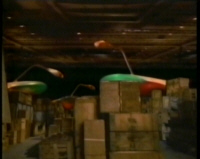 Despite their differences, by the end of the first two part episode, Blackwood and his team have prevented
the aliens from re-activating a cache of mothballed War Machines, warehoused
alongside other forbidden objects in a scene that was actually a neat little nod to Raiders Of
The Lost Ark. If you want proof of that, take a look at the image above (click image for a larger version) and you'll see a burnt-out
Nazi emblem on one of the crates, which absolutely connects this scene to Raiders of the Lost Ark. Thanks
to visual effects supervisor Michael Lennick for confirming this fascinating piece of trivia.
Despite their differences, by the end of the first two part episode, Blackwood and his team have prevented
the aliens from re-activating a cache of mothballed War Machines, warehoused
alongside other forbidden objects in a scene that was actually a neat little nod to Raiders Of
The Lost Ark. If you want proof of that, take a look at the image above (click image for a larger version) and you'll see a burnt-out
Nazi emblem on one of the crates, which absolutely connects this scene to Raiders of the Lost Ark. Thanks
to visual effects supervisor Michael Lennick for confirming this fascinating piece of trivia.
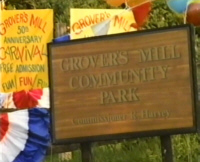 The episodes
that follow are generally quite good, especially the brilliant An Eye For An Eye, which weaves
in the 1938 radio broadcast to considerable effect. The series always plays fast and loose
with the formulas of the genre, such that rather unusually, there is a
real feeling of threat to the episodes. Victory is never entirely certain, and the aliens
don't simply get beaten every week. Harrison and his team are not well supported by the
government and are something of a low budget department, but the aliens themselves have their difficulties, particularly
their problems with the radiation that revived them. In a bit of a double edged sword, it
also kills off their human hosts. This gives ample opportunity to show Martians in various
stages of gruesome decay. The episodes
that follow are generally quite good, especially the brilliant An Eye For An Eye, which weaves
in the 1938 radio broadcast to considerable effect. The series always plays fast and loose
with the formulas of the genre, such that rather unusually, there is a
real feeling of threat to the episodes. Victory is never entirely certain, and the aliens
don't simply get beaten every week. Harrison and his team are not well supported by the
government and are something of a low budget department, but the aliens themselves have their difficulties, particularly
their problems with the radiation that revived them. In a bit of a double edged sword, it
also kills off their human hosts. This gives ample opportunity to show Martians in various
stages of gruesome decay.
The creative force behind the show was producer/writer Greg Strangis. He had
some serious aspirations for the show, seeing it as an opportunity to highlight
our poor treatment of the planet, and that the aliens might simply be our
destined replacements in the natural scheme of things.
Production values are not especially high, (budgets ran to about $680,000 per
episode) but the series is imaginatively designed and the crew get every dollar
on the screen. The Martians are largely bereft of their advanced technology, and so have to make
do with scavenging for surplus human equipment and bending it to their needs. This makes for a marvellously quirky
style as they cobble together bizarre machines from any old bits and pieces they
can lay hands on. At the same time, the alien leaders (the three member Advocacy)
are as seriously a creepy group of monsters as you could ever hope for. Clad in
black leather suits full of coolant to keep their host bodies from succumbing to the
radiation), they simply exude menace.
The series did come under some flak for the level of gore, which aliens dissolving,
exploding and generally meeting some fairly sticky ends, but really this was nothing
to complain about, and combined with the other unusual elements of the show, just
added further to the feeling that this really was a genuinely odd piece of work.
 Alas for the second season, the show changed character completely. The title was
changed to "The War of the Worlds - The Second Invasion". Ironhorse and
Drake were killed off, and a new entirely different set of aliens arrived on earth
to take over the battle. Called the Morthrai, these aliens hail from the planet Mortax
and it is revealed that the first aliens (were they ever really Martians?) were the foot
soldiers of the Morthrai. The Morthrai execute the first aliens for their failure to overcome the
humans and take over the battle. No longer do they have to inhabit human bodies
and so we now have some recurring alien characters. Alas for the second season, the show changed character completely. The title was
changed to "The War of the Worlds - The Second Invasion". Ironhorse and
Drake were killed off, and a new entirely different set of aliens arrived on earth
to take over the battle. Called the Morthrai, these aliens hail from the planet Mortax
and it is revealed that the first aliens (were they ever really Martians?) were the foot
soldiers of the Morthrai. The Morthrai execute the first aliens for their failure to overcome the
humans and take over the battle. No longer do they have to inhabit human bodies
and so we now have some recurring alien characters.
These episodes are not as bad as generally considered, but
the changes are jarring and not well explained. Suddenly the world is a run-down
place, suffering economic disaster and environmental blight. When did all this
happen and why? It's a pretty unsatisfying situation, and one that did the series
no favours as it was cancelled at the end of the season, though it did end
unusually for a cancellation, with an actual resolution provided to the story. In a sudden about face, the Morthrai realise
that they have been misled by their leaders and overthrow them. Peace is declared.
|
Buy
See also in:
Film & TV
|
1953
The War of the Worlds by George Pal. The action relocates to cold war America, with the Martian war machines re-invented as sinister flying machines.
|
|
1968
Robinson Crusoe on Mars. The Martian war machines from the George Pal movie are the foe for an astronaut stranded on Mars.
|
|
1975
War of the Worlds TV Series by George Pal. Who knew that George Pal once planned a television series spin off from his 1953 movie?
|
|
